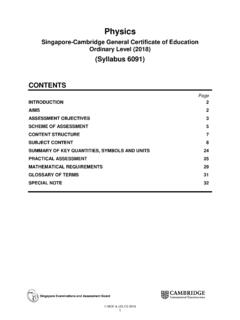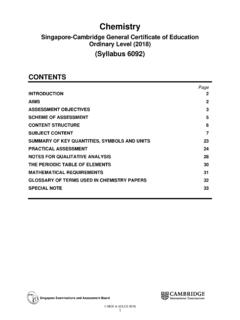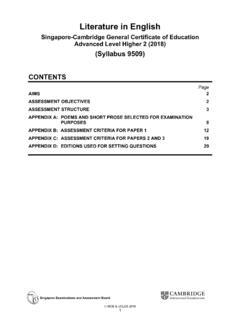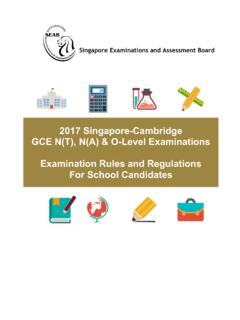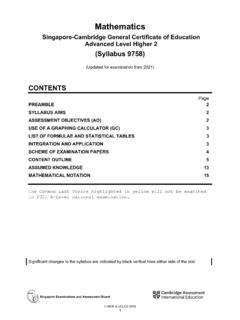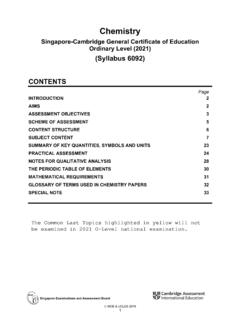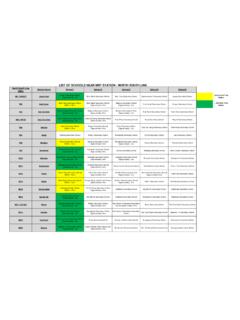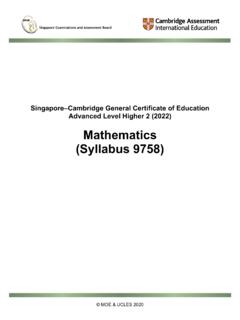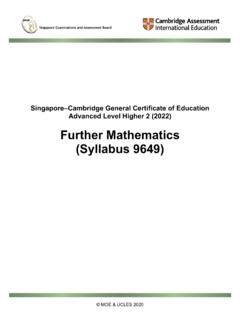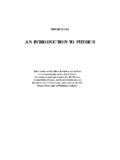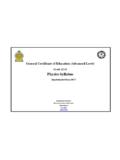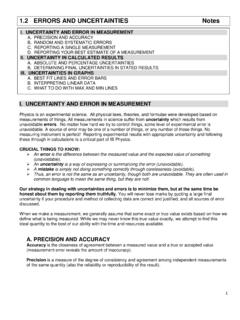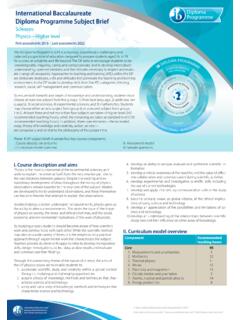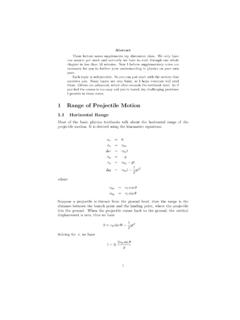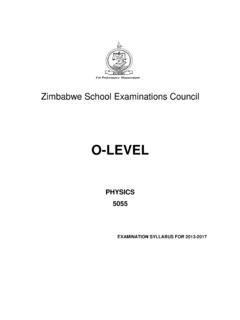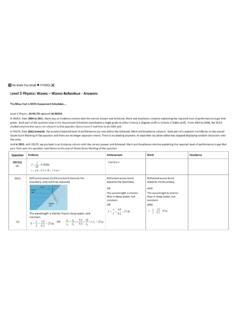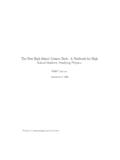Transcription of 9749 y17 sy Physics H2 for 2017 - SEAB - Home
1 MOE & UCLES 2015 1 Singapore Examinations and Assessment Board Physics Higher 2 (2017) (Syllabus 9749) CONTENTS Page INTRODUCTION 2 AIMS 2 PRACTICES OF SCIENCE 2 CORE IDEAS IN Physics 4 CURRICULUM FRAMEWORK 6 ASSESSMENT OBJECTIVES 7 SCHEME OF ASSESSMENT 8 ADDITIONAL INFORMATION 9 SUBJECT CONTENT 10 PRACTICAL ASSESSMENT 27 MATHEMATICAL REQUIREMENTS 30 GLOSSARY OF TERMS 32 TEXTBOOKS 33
2 SUMMARY OF KEY QUANTITIES, SYMBOLS AND UNITS 34 DATA AND FORMULAE 36 9749 H2 Physics (2017) 2 INTRODUCTION The syllabus has been designed to build on and extend the content coverage at O-Level. Candidates will be assumed to have knowledge and understanding of Physics at O-Level, either as a single subject or as part of a balanced science course. AIMS The aims of a course based on this syllabus should be to: 1. provide students with an experience that develops their interest in Physics and builds the knowledge, skills and attitudes necessary for further studies in related fields 2.
3 Enable students to become scientifically literate citizens who are well-prepared for the challenges of the 21st century 3. develop in students the understanding, skills, ethics and attitudes relevant to the Practices of Science, including the following: understanding the nature of scientific knowledge demonstrating science inquiry skills relating science and society 4. develop in students an understanding that a small number of basic principles and core ideas can be applied to explain, analyse and solve problems in a variety of systems in the physical world. PRACTICES OF SCIENCE Science as a discipline is more than the acquisition of a body of knowledge ( scientific facts, concepts, laws, and theories) it is a way of knowing and doing.
4 It includes an understanding of the nature of scientific knowledge and how this knowledge is generated, established and communicated. Scientists rely on a set of established procedures and practices associated with scientific inquiry to gather evidence and test their ideas on how the natural world works. However, there is no single method and the real process of science is often complex and iterative, following many different paths. While science is powerful, generating knowledge that forms the basis for many technological feats and innovations, it has limitations. The Practices of Science are explicitly articulated in the syllabus to allow teachers to embed them as learning objectives in their lessons.
5 The students understanding of the nature and the limitations of science and scientific inquiry are developed effectively when the practices are taught in the context of relevant science content. Attitudes relevant to science such as inquisitiveness, concern for accuracy and precision, objectivity, integrity and perseverance should be emphasised in the teaching of these practices where appropriate. For example, students learning science should be introduced to the use of technology as an aid in practical work or as a tool for the interpretation of experimental and theoretical results. 9749 H2 Physics (2017) 3 The Practices of Science comprise three components: 1.
6 Understanding the Nature of Scientific Knowledge Understand that science is an evidence-based, model-building enterprise concerned with the natural world Understand that the use of both logic and creativity is required in the generation of scientific knowledge Recognise that scientific knowledge is generated from consensus within the community of scientists through a process of critical debate and peer review Understand that scientific knowledge is reliable and durable, yet subject to revision in the light of new evidence 2. Demonstrating Science Inquiry Skills Identify scientific problems, observe phenomena and pose scientific questions/hypotheses Plan and conduct investigations by selecting appropriate experimental procedures, apparatus and materials, with due regard for accuracy, precision and safety Obtain, organise and represent data in an appropriate manner Analyse and interpret data Construct explanations based on evidence and justify these explanations through reasoning and logical argument Use appropriate models1 to explain concepts, solve problems and make predictions Make decisions based on evaluation of evidence, processes.
7 Claims and conclusions Communicate scientific findings and information using appropriate language and terminology 3. Relating Science and Society Recognise that the application of scientific knowledge to problem solving could be influenced by other considerations such as economic, social, environmental and ethical factors Demonstrate an understanding of the benefits and risks associated with the application of science to society Use scientific principles and reasoning to understand, analyse and evaluate real-world systems as well as to generate solutions for problem solving 1 A model is a representation of an idea, an object.
8 A process or a system that is used to describe and explain phenomena that cannot be experienced directly. Models exist in different forms from the concrete, such as physical, scale models to abstract representations, such as diagrams or mathematical expressions. The use of models involves the understanding that all models contain approximations and assumptions limiting their validity and predictive power. 9749 H2 Physics (2017) 4 CORE IDEAS IN Physics Physics encompasses the study of systems spanning a wide range of distances and times: from 10 15 m ( sub-atomic particles) to larger than 1030 m ( galaxies); from near-instantaneous events, such as the current flow with a flick of a switch, to slow-evolving phenomenon, such as the birth and death of a star.
9 A small number of basic principles and laws can be applied in the study and interpretation of this wide variety of simple and complex systems. Similarly, a few core ideas that cut across traditional content boundaries can be introduced in the curriculum to provide students with a broader way of thinking about the physical world. These Core Ideas are fundamental in the study of Physics and help students integrate knowledge and link concepts across different topics. They provide powerful analytical tools which can explain phenomena and solve problems. 1. Systems and Interactions Defining the systems under study (by specifying their boundaries and making explicit models of the systems) provides tools for understanding and testing ideas that are applicable throughout Physics .
10 Objects can be treated as having no internal structure or an internal structure that can be ignored. A system, on the other hand, is a collection of objects with an internal structure which may need to be taken into account. Physical events and phenomena can be understood by studying the interactions between objects in a system and with the environment. Students should be able to identify causal relationships when analysing interactions and changes in a system. Interactions between objects in a system can be modelled using forces ( a system of forces applied to move a mass; a system of two masses colliding; a system of the moon orbiting around the Earth; a system of electrical charges; a system of current in a straight wire placed in a magnetic field).
